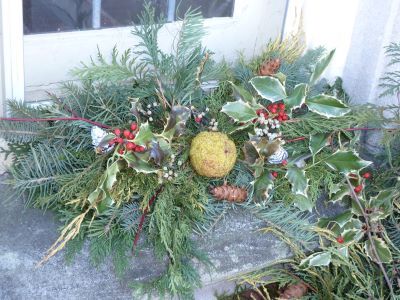
Good Natured: Deck the Halls with An Osage Orange
I know, holly is the traditional plant to mix in with pine, spruce and fir sprigs, but isn't it nice to mix things up every once in a while?
Besides, when you add in some hedge apples, a.k.a. osage oranges or Maclura pomifera, you're not only adding some delightful shades of bright lime, you're also incorporating an ecological anachronism—just the thing to spark conversation 'round the ol' wassail bowl.
If we could travel back in time a few million years, we'd see that osage orange trees had a broad distribution in North America. But since we can't, we'll instead take a look at fossil records that show Maclura pollen—which is dispersed by wind—ranged far and wide before our last Ice Age. Yet when European settlers pushed past the Mississippi River and “discovered" the tree, its range consisted of a small area amid the Red River watershed at the juncture of Texas, Oklahoma and Arkansas. What the heck happened?
Basically, the tree lost its means of transportation—at least temporarily. Plants need a way to disperse their seeds in order to keep or expand their range. Picture a blue jay flying with acorns stuffed in its gullet. Most will get eaten but those that don't produce, voila! An oak seedling sprouts far away from the mother oak.
It's kinda the same thing with the big, goofy osage orange fruits. Only instead of blue jays, their dispersers were the big, goofy and now extinct megafauna of the Pleistocene epoch—the mammoths, mastodons and, some research suggests, native horses. When these animals disappeared around 10,000 years ago, no other animals picked up the task of eating the fruit and dispersing the seeds. As a consequence, the tree's range shrank, and shrank some more, til it settled along the Red River—an anachronism, or relic, of a former time.
It might've stayed just that, a stand of trees producing fruits no one wanted, were it not for an entirely different group of mammals: humans. First came the Native Americans, who discovered the osage orange tree (the name can be traced to the Osage tribe) had wood that was both very strong and very flexible. It made the BEST tools, especially bows, and burned hotter than any other firewood.
There's some question as to whether the Osage traded the fruits of the tree or merely its wood, but there's no doubt that the tree was highly valued. (National Geographic researchers found an early 1800s reference stating that a bow made from osage orange carried a price of “a horse and blanket.")
But the tree's popularity really took off when the European settlers arrived in the region. These pioneers planted the trees as windbreaks to slow soil erosion caused by the prairie's prevailing winds, and to serve as the fencing they needed to contain roaming cattle.
The trees were planted close together, in a row, and their tops were cut off so they'd grow shrubby instead of tall. The plants' prickly, sinuous branches would, over time, knit together to form an impenetrable hedge that was “horse high, bull strong and hog tight."
When barbed wire came on the scene in the 1870s, it could have spelled the end of osage orange's popularity. But because fence wire is useless without fence posts, and because osage orange wood resists rot, insects and sun damage, the tree's use remained high.
Have you ever looked at an old wire fencerow? Did you notice how many of the posts are downright crooked? Chances are these are made from osage orange. The tree's twisty, knotted growth habit makes it unsuitable for use as planks, but excellent for fence posts, wagon wheels and bow staves.
Its wood is remarkable, but let's get back to that namesake fruit. Its flesh is laced with milky, bitter sap that might have been palatable to mastodons and mammoths but not too many other critters. Horses, mules and deer like them, and determined squirrels will chew through the pulp to get to the seeds—as many as 200 per orange/apple/brain—which have a mild and not unpleasant taste. (Yes, this determined naturalist has tried a few too, for the sake of accurate reporting.)
Their pleasant scent is reputed to repel spiders, mice, ants and other insects. But seeing as I've had a bucket of the fruit in my garage for some time, and still have spiders, et al aplenty, I can't recommend it as a critter deterrent. But as a holiday decoration? You betcha. Fa-la-la-la, la-la-la-la!
Pam Otto is the outreach ambassador for the St. Charles Park District. She can be reached at potto@stcparks.org.

